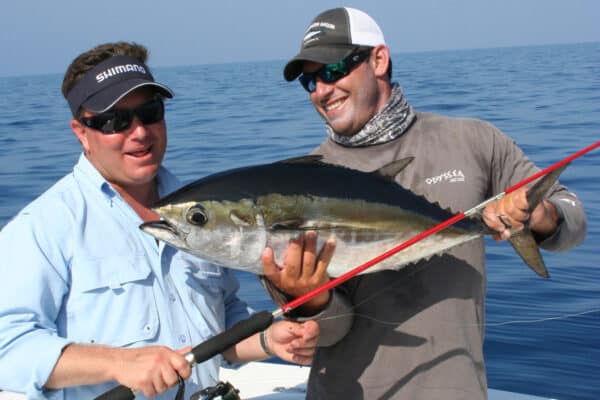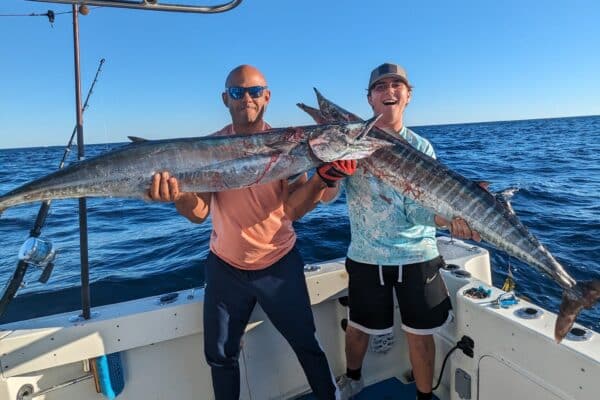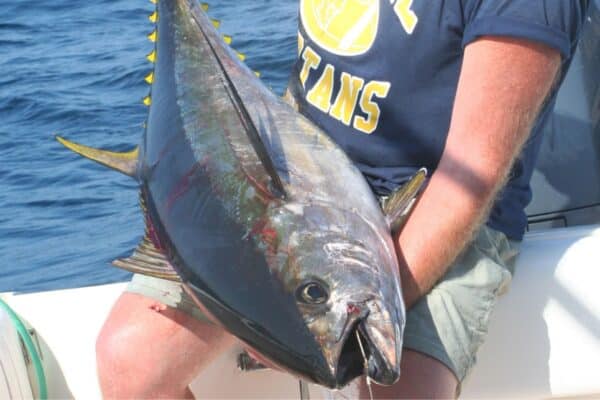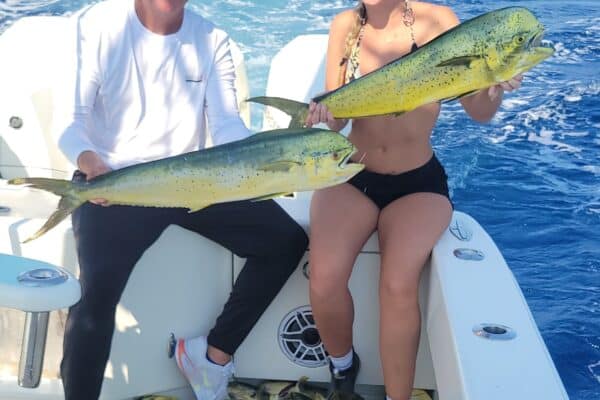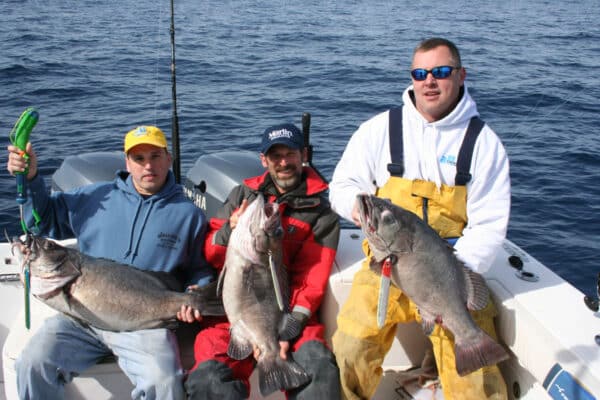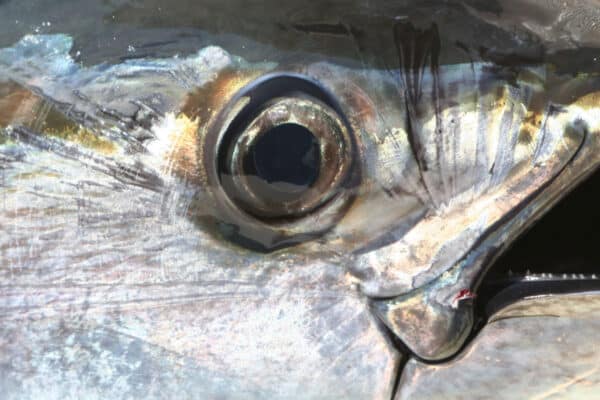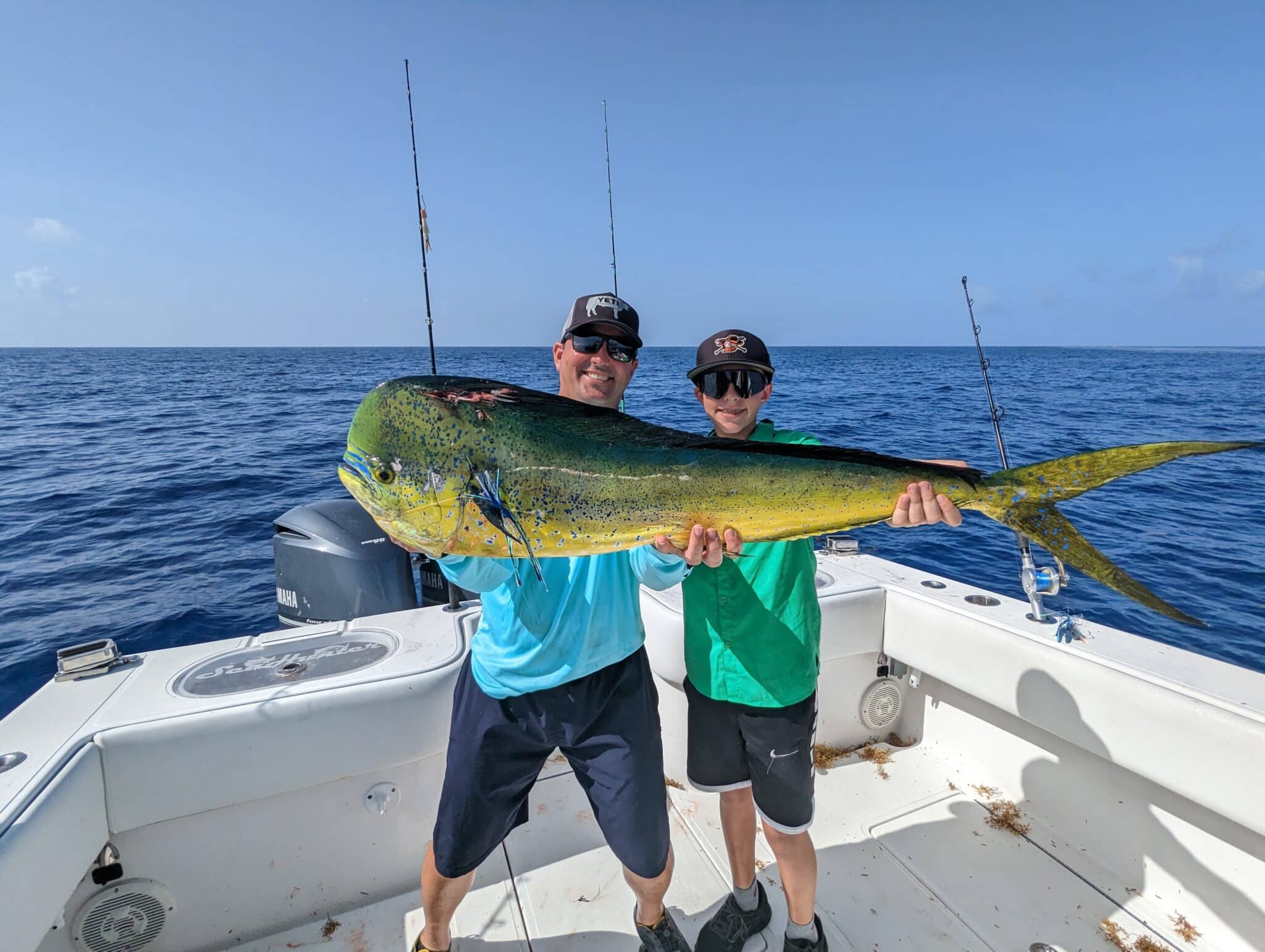
I have been using SatFish High-Def SST technology to find and catch Mahi Mahi during the summer season for over two years, and I am excited to share my experience with you all. In this guide, I will share some tips and tricks on using this technology effectively and increasing your chances of catching Mahi Mahi during the hot summer days.
Why Use SatFish High-Def SST for Mahi Mahi Fishing?
Mahi Mahi are known to be highly migratory fish, so finding them can be challenging. They prefer warmer waters and stay in areas with water temperatures between 75°F to 85°F. SatFish High-Def SST technology allows you to identify these temperature zones and locate the best spots for Mahi Mahi fishing in the Florida Keys. This technology also shows ocean currents, eddies, and other vital features that can help you locate places that will hold the Florida Keys mahi-mahi offshore during summer.
So, how can you use SatFish High-Def SST to catch Mahi Mahi offshore during the summer heat? Let’s dive into the details.
Understanding Mahi Mahi Behavior During Summer Heat
Before we discuss using SatFish High-Def SST to catch Mahi Mahi, it’s essential to understand their behavior during the summer months. Generally, Mahi Mahi can be caught off floating objects such as sargassum and debris. These objects create shade and attract smaller baitfish, attracting larger fish like Mahi Mahi. The Florida Keys Mahi Mahi also tend to stay in areas with sharp temperature breaks, which can be detected using SatFish High-Def SST technology.
Identify Temperature and Color Breaks: Finding Convergence Zones
A great technique to enhance your Florida Keys experience when the water temperatures start to soar is to use SATFISH SST services to locate temperature breaks.
During June, July, and August, a 1-degree temperature break (hard edge) at 85-86 F can hold plankton and baitfish in the area, making it a popular feeding ground for baitfish and Florida Keys dolphins, known as convergence zones.
These zones are dynamic regions where different water masses collide, interact, and shape a unique environment for marine life to thrive. Just think of conveyor belts running in opposite directions, each carrying distinct water properties.
The Creation of Convergence Zones
Underwater convergence zones form when ocean currents with different temperatures, salinities, and densities converge. These currents, driven by wind patterns, tides, and Earth’s rotation, carry water masses from various regions and depths. As these water masses meet, they create boundaries where their characteristics mingle, forming convergence zones.
Interplay of Water Masses
Similar to how two rivers merge, meeting water masses in convergence zones causes intricate interactions. Think of it as a dance between warm and cold water, each performing uniquely. Warm water tends to rise, while cold water sinks. This vertical mixing results in a complex layering effect, influencing the distribution of nutrients, oxygen levels, and temperature gradients within the zone.
Impact on Marine Life
Convergence zones play a crucial role in shaping the ecology of the marine realm. Their dynamic nature provides a rich tapestry of resources, affecting many marine species’ feeding and breeding behaviors. Nutrient-rich waters from deeper layers are often brought up to the surface, fueling the growth of microscopic phytoplankton. This abundance then cascades up the food chain, attracting larger organisms like zooplankton, fish, and even marine mammals.
Visualizing the Impact
Imagine a grand banquet where the convergence zone acts as the central Florida Keys dolphin buffet table.
- Phytoplankton, like delicate appetizers, float near the surface, soaking up sunlight and nutrients.
- Zooplankton, the main course, feasts on this abundant feast, attracting many fish and resembling eager diners enjoying the bounty.
- Predators, the apex of this underwater gastronomy, patrol the edges of the convergence zone, ready to pounce on unsuspecting prey.
To locate these Florida Keys convergence zone areas, look for sudden changes in water temperature on the SATFISH SST Charts, which indicate a temperature break.
Additionally, look for color breaks where clean offshore water meets the coastal shelf and canyon edges, and refer to the SATFISH bathymetry charts for assistance.
These areas will have a unique blue color contrasting with the surrounding waters. Using SatFish high-def SST, water color, and bathymetry layers, you can identify areas where Florida Keys dolphins will likely be found. Look for sites where the temperature and color breaks overlap with the top of the drop-off for steep walls and humps. These areas are ideal for seeing dolphins and marlin in the Florida Keys during the hot summer.
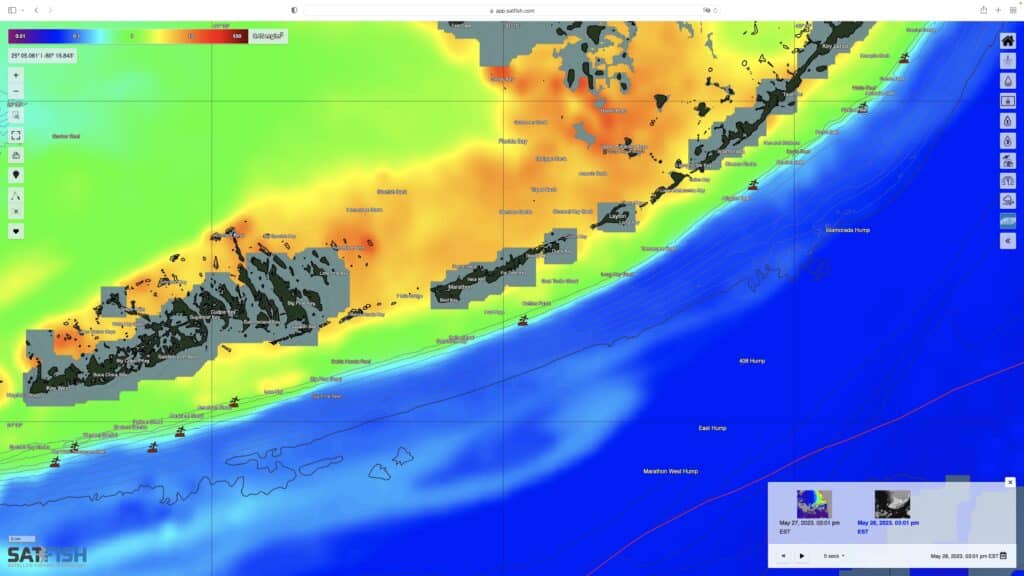
By understanding the role of convergence zones, you can improve your chances of finding Mahi Mahi offshore and experiencing a successful fishing trip. Use SatFish high-def SST services to identify temperature and color breaks and bathymetry charts to locate these dynamic areas where marine life thrives. Remember that convergence zones like to move around and can change in location, size, and intensity, so check SATFISH SST charts frequently for the most accurate information. With these tools, you can enhance your fishing experience and reel in some impressive catches while exploring the beautiful waters of the Florida Keys. So next time you’re planning a fishing trip in this area, remember to utilize the charts.
Temperature Breaks-Florida Keys Fishing Spots
Temperature breaks (edges either soft or hard) are areas with a distinct change in water temperature. These breaks serve as boundaries that separate different habitats and can significantly influence fish behavior. Temperature anomalies refer to abnormal variations in water temperature on either side of a fish break. These anomalies can occur due to natural processes such as upwellings, thermoclines, or weather events like cold fronts or heat waves. The impact of temperature anomalies on fish behavior is complex and can vary depending on the species involved.
Find the Sargassum Weedlines with SATFISH
To find the best Florida Keys fishing spots for tuna and dolphins, it’s essential to understand their migration patterns and the ocean currents. One strategy is to use the SATFISH Offshore service to identify specific areas where these fish are likely present. Combining knowledge of currents with interpreting SATFISH SST charts allows you to locate feeding grounds for baitfish and larger predatory fish.
If you’re seeking a method to locate sargassum weed lines in the Florida Keys, using SST services to identify temperature breaks(edges) is reliable. Find these weed lines where warm and cool water masses converge. SST charts are an invaluable tool for fishermen looking to pinpoint these areas and improve their chances of finding sargassum mats. SST data can help Florida Keys fishermen have a more successful dolphin fishing trip when combined with other information such as ocean currents and sargassum mat indicators.
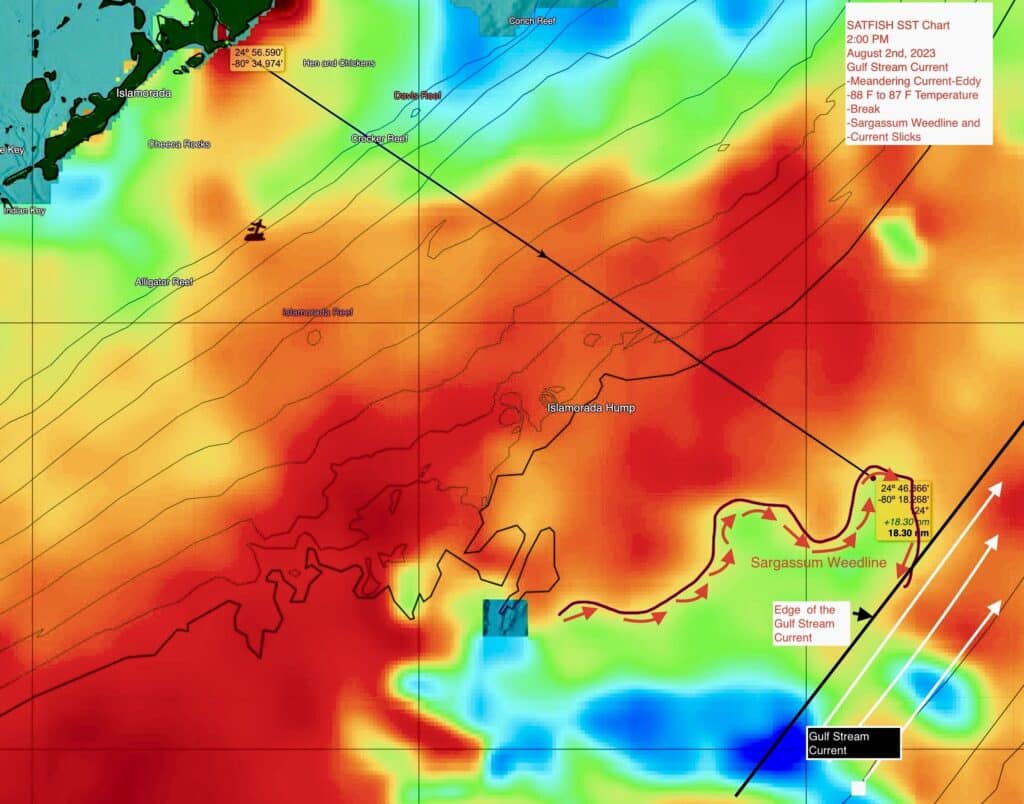
Subtle vs. Hard Edge Rips
If you’re looking to catch Mahi Mahi offshore, taking advantage of temperature anomalies is essential to increase your chances of success. Mahi Mahi are highly migratory and are known to follow temperature breaks to optimize feeding opportunities and locate prey.
One good place to look for Mahi Mahi is where warm and cold water masses collide, creating a rich and diverse ecosystem supporting their prey. These anomalies can create areas where Mahi Mahi are more likely to be concentrated due to increased productivity, food availability, or better spawning conditions.
Using SATFISH to locate the edge of the Gulf Stream can be a great starting point for finding Mahi Mahi, as these fish often congregate where warm and cold-water masses meet. Utilizing this strategy can improve your chances of a successful fishing trip and potentially catch more Mahi Mahi.
One morning last July, I discovered a “hard edge” rip temperature break on SATFISH Offshore and inputted the coordinates into my boat’s GPS. We headed straight to the location and caught a limit of mahi mahi within three hours of leaving the dock, including a 30-pound bull dolphin. When fishing for Mahi Mahi offshore, it’s crucial to understand their behavior when encountering temperature break anomalies.
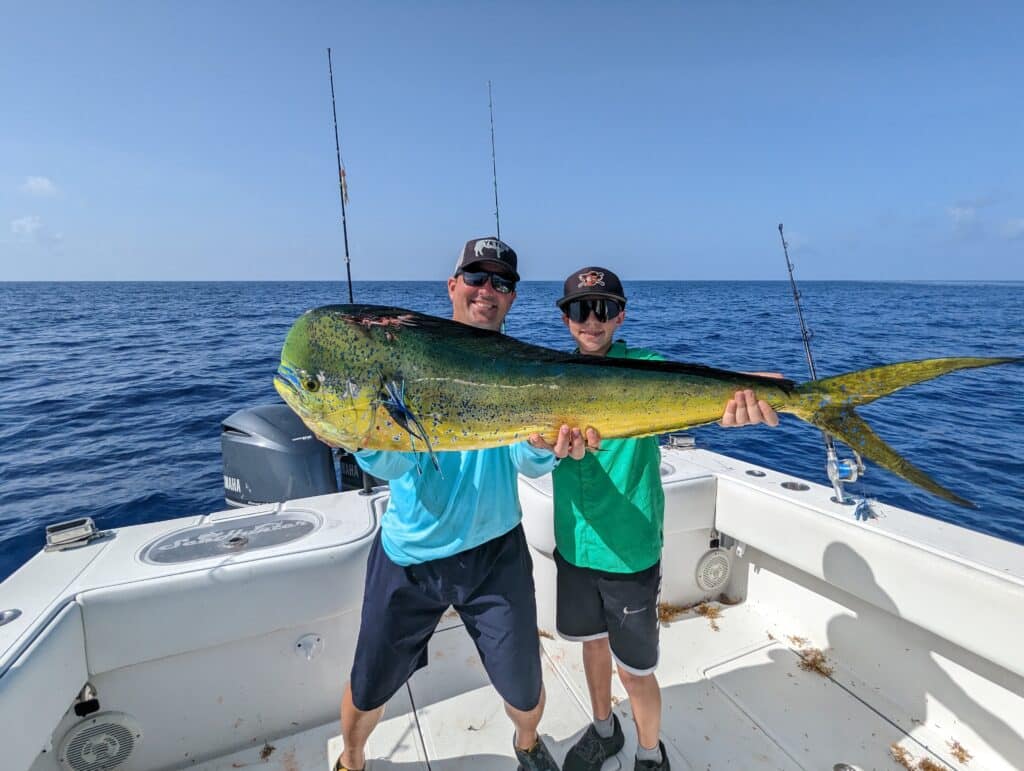
How to Troll Areas Along the Weed Line
By aligning my boat movement with the counterclockwise current of the Gulf Stream, I do my best to imitate the natural behavior of baitfish and other marine life (like krill, filefish, triggerfish, flying fish, and crabs) that move with these currents. This trolling method can be particularly effective for attracting species like mahi mahi and wahoo. By following the weed lines, I will likely end up at the tip of a finger or in a backflow eddy – both highly productive.
If trolling along the rip doesn’t yield the results I am looking for, I pivot my focus to the center of the weed line. By continuing to follow the currents (moving south when west of the center and north when east), I am still mimicking the natural movement patterns within the feature. This will typically lead me to areas where fish are more likely to congregate.
Rips are visible disturbances on the water’s surface that appear as long, narrow bands of calm water bracketed on either side by rough water. Rips form at or near temperature boundaries. These boundaries are referred to as “soft edges” when the change across them is only .5°F to 1°F, and hard edges when the change is 1.5°F to 4°F(or more). The rough water at hard edge rips is more pronounced than at soft edges.
Depending on the species and their preferences, Mahi Mahi may avoid or be attracted to different temperatures. For instance, during a heatwave, they may seek out cooler water near upwelling zones or move along the sargassum weed line to find more favorable temperatures and baitfish. I highly recommend anglers use SATFISH SST charts to locate offshore temperature breaks.
In the summer, cold water temperature breaks may be more attractive to Mahi Mahi, while warm water temperature breaks may be more effective in winter. Utilizing these charts to narrow your search areas can significantly improve your fishing success and catch more mahi mahi and wahoo. When targeting Mahi Mahi in different seasons, always consult SATFISH SST charts for real-time information on temperature breaks.
Temperature boundaries, primarily the hard edge rips like the ones we see in the early spring and late summer months in the Florida Keys, can act as a “wall” when the temperature on one side falls within a game fish’s comfort range and that on the other side does not. Wahoo and Mahi mahi mahi will tend to move along these hard edges when they encounter them instead of crossing them.
Conclusion
The patterns of the mahi-mahi migration are constantly changing due to environmental factors such as temperature and weather. Therefore, if you want to increase your chances of catching these fish, it’s essential to consider and plan your fishing trip accordingly. By learning about the migration patterns of mahi-mahi, you’ll be better prepared to go out on the water and have a successful fishing expedition.
Using SatFish high-def SST, watercolor, and bathymetry layers can help you locate areas where temperature breaks overlap with color breaks and drop-offs in the Florida Keys. Remember to track your location on the SATFISH mobile app. Now go catch them up!
Check out my video where I further explain how to use SatFish to target Mahi and other species!

